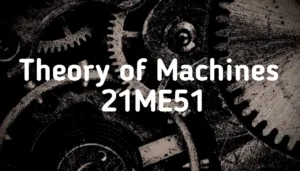
Theory of Machines 21ME51
Module 1`
Introduction: Mechanisms and machines, Kinematic pairs-types, degree of freedom, Kinematic chains and their
classification, Kinematic inversions,
Velocity and Acceleration analysis of planar mechanisms Graphical method: Velocity and Acceleration Analysis of
Mechanisms Velocity and acceleration analysis of four bar mechanism, slider crank mechanism. Mechanism illustrating
Corioli’s component of acceleration. Angular velocity and angular acceleration of links, velocity of rubbing.
Velocity and Acceleration Analysis of Mechanisms (Analytical Method):Velocity and acceleration analysis of
four bar mechanism, slider crank mechanism using complex algebra method.
Module 2
Static force analysis: Static equilibrium, analysis of four bar mechanism, slider crank mechanism.
Dynamic force analysis: D’Alembert’s principle, analysis of four bar and slider crank mechanism.
Flywheel: Introduction to Flywheel and calculation of its size for simple machines like punching machine, shearing
machine
Module 3
Spur Gears: Gear terminology, law of gearing, path of contact, arc of contact, contact ratio of spur gear. Interference in
involute gears, methods of avoiding interference, condition and expressions for minimum number of teeth to avoid
interference.
Gear Trains: Simple gear trains, compound gear trains. Epicyclic gear trains: Algebraic and tabular methods of finding
velocity ratio of epicyclic gear trains, torque calculation in epicyclic gear trains. Discussions on applications of gear trains.
Module 4
Balancing of Rotating Masses: Static and Dynamic Balancing, Balancing of single rotating mass by balancing masses in
same plane and in different planes. Balancing of several rotating masses by balancing masses in same plane and in
different planes. Discussions on applications.
Balancing of Reciprocating Masses: Inertia Effect of crank and connecting rod, Single cylinder Engine, Balancing in multi
cylinder-inline engine (primary and secondary forces). Discussions on applications
Governors:Types of Governors; Force Analysis of Porter and Hartnell Governors. Controlling Force, Stability,
Sensitiveness, Isochronism, Effort and Power. Discussion on applications.
Module 5
Free vibrations: Basic elements of vibrating system, Types of free vibrations, Longitudinal vibrations- Equilibrium
method, D’Alembert’s principle, Determination of natural frequency of single degree freedom systems, Damped free
vibrations: Under damped, over damped and critically damped systems. Logarithmic decrement.
Forced vibrations: Undamped forced vibration of spring mass system, Damped forced vibrations, Rotating unbalance,
Reciprocating unbalance, Vibration isolation, Critical speed. Discussions on applications.
You are so interesting! I don’t suppose I have read through something like this before. So nice to find another person with a few original thoughts on this issue. Really.. many thanks for starting this up. This website is one thing that is required on the web, someone with a bit of originality.
I needed to thank you for this wonderful read!! I definitely loved every bit of it. I have you saved as a favorite to look at new stuff you post…
Very good article. I’m experiencing many of these issues as well..
I really like reading through an article that can make men and women think. Also, thanks for allowing for me to comment.
Very good article. I’m experiencing some of these issues as well..
I was able to find good info from your blog articles.
This website really has all the information I needed about this subject and didn’t know who to ask.
I love it when individuals come together and share opinions. Great blog, continue the good work.
It’s hard to find experienced people on this subject, however, you sound like you know what you’re talking about! Thanks
Aw, this was a really nice post. Taking a few minutes and actual effort to create a really good article… but what can I say… I procrastinate a whole lot and never seem to get anything done.
Your style is so unique compared to other folks I’ve read stuff from. Thanks for posting when you’ve got the opportunity, Guess I will just book mark this web site.
I was examining some of your blog posts on this internet site and
I believe this website is rattling instructive! Keep posting.!
Awsome info and straight to the point. I am not sure if this is actually the best place to ask but do
you folks have any thoughts on where to hire some professional writers?
Thank you 🙂 Escape room